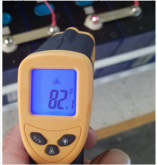Frank in Thailand
making mistakes so you don't have to...
For normal mechanical situation, yesOr a stud with large nut between battery and busbar, so more torque could be applied to busbar connection without over-torquing the weaker thread in the battery.
Here is the copper contact to the aluminium the most important factor.
The stud is the least conductive part in the whole setup.
(A stud of aluminium/copper might work, not locally for sale, not in China.
Iron, 304, carbon steel, enough threaded rods and headless bolts.
Aluminium and copper? None.)
Yes, thin layer is more easy flatened then thicker.
Good for me they are flat and don't need it.
One most important part of "the best way" is availablity.
(Vs usage, time and costs)
Getting oxi-guard is really expensive if I want to use it this month.
Or even next Month.
It's cheaper to get silver conductive paste.. $2.50 for 0.7 ml
Only little bit is needed.
And here next week.
I'll make a new post for building the "optimal powerbank" from LiFePO4 cells
Or atleast my efforts to make it,
With pictures.
Almost all parts are in.
Now I need to solder my remaining 0603 thermistors onto wires to measure the temperature of the cells.
That will need the microscope again




